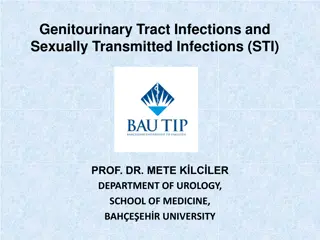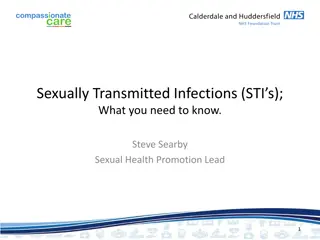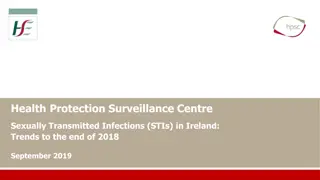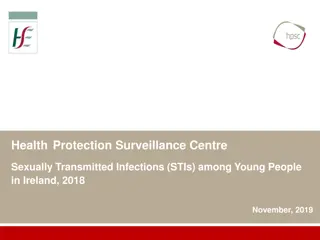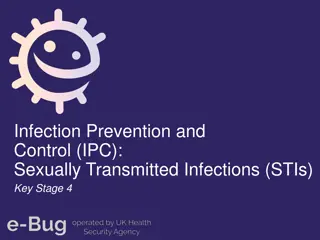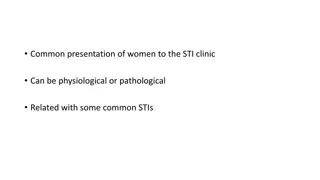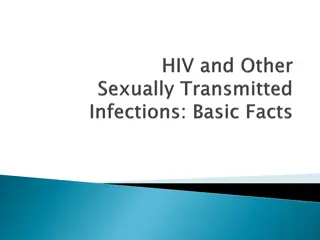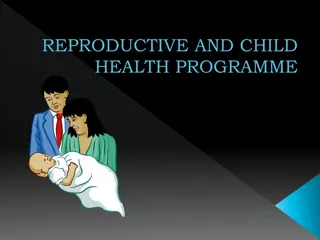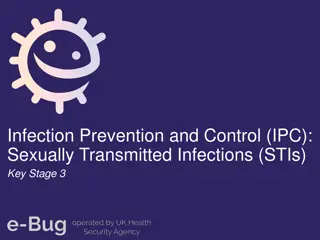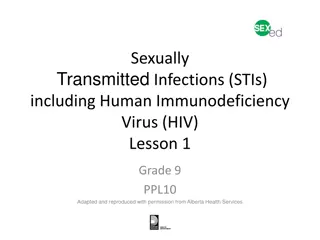
Understanding STIs: Symptoms, Statistics, and Risks
Explore the world of STIs, from bacterial vs. viral infections, general symptoms, statistics on teens and STIs, to in-depth insights on HIV/AIDS and HPV. Learn about the prevalence, risks, and implications of sexually transmitted infections. Stay informed for a healthier future.
Download Presentation

Please find below an Image/Link to download the presentation.
The content on the website is provided AS IS for your information and personal use only. It may not be sold, licensed, or shared on other websites without obtaining consent from the author. If you encounter any issues during the download, it is possible that the publisher has removed the file from their server.
You are allowed to download the files provided on this website for personal or commercial use, subject to the condition that they are used lawfully. All files are the property of their respective owners.
The content on the website is provided AS IS for your information and personal use only. It may not be sold, licensed, or shared on other websites without obtaining consent from the author.
E N D
Presentation Transcript
STIs Sexually Transmitted Infections
Bacterial vs. Viral STIs Bacteria can be cured with antibiotics Viral diseases are not curable Both bacterial and viral infections can have permanent changes to your body. virus1 EBsOnRBCs
Bacterial STIs Chlamydia Gonnorhea Syphilis PenileDischrgGonococcal3_991209
Viral STIs herpes Herpes HPV HIV/AIDS Hepatitus genital-warts-female
GENERAL SYMPTOMS STIs can present themselves with some, all, or none of the following: Itching Hurts to pee Change in colour or odour of discharge (female) Any penile discharge Change in periods (painful, spotting, increased /decreased flow) Bumps, lumps, sores Rash Abdominal pain Pain with intercourse NO SYMPTOMS AT ALL Some of these STIs and their symptoms can be permanent and can also lead to chronic pain, emotional distress, infertility, and even death.
STATISTICS on TEENS, SEX, & STIs New estimates show that there are about 20 million new infections in the United States each year. Young people age 15 to 24 account for 50 percent of all new STIs, although they represent just 25 percent of the sexually experienced population. Roughly 75 percent of all reported gonorrhea is found in people age 15 to 29, with the highest infection rates found in teen girls age 15 to 19 and 20 to 24-year-old men. The Centers for Disease Control and Prevention estimates that there are more than 110 million STIs among men and women in the U.S. This includes both new and existing infections. The annual number of new infections is roughly equal among teen girls (51 percent) and teen guys (49 percent).
HIV/AIDS HIV = Human Immuno-Deficiency Virus (virus indicates that it is NOT curable) AIDS = Acquired Immuno-Deficiency Syndrome (it is the second stage of HIV and is also non-curable) People do not die from AIDS. They die from opportunistic infections which are other colds and viruses that their weakened immune system cannot fight.
HPV (human papillomavirus) accounts for the majority of prevalent STIs in the U.S. The U.S. has the highest rate of STIs in the industrialized world. 46% of American high school students have had sexual intercourse and potentially are at risk for human immunodeficiency virus (HIV) infection and other STIs. 6 in 10 sexually active high school teens reported using condoms during their most recent sexual intercourse. 1 IN 4 TEENS CONTRACTS AN STI EVERY YEAR. Less than half of adults age 18 to 44 have ever been tested for an STI other than HIV/AIDS. http://www.thecollegianur.com/wp-content/uploads/2009/09/condom-61.jpg
PREVENTION & PROTECTION Abstinence Condom use Monogamous relationships Routine testing Vaccinations
Protection from Pregnancy vs Protection from STIs Birth control can help prevent pregnancy but it DOES NOT protect you from STIs. If you plan to be sexually active, ALWAYS use a condom to help protect against STIs
EARLY DETECTION The early detection and treatment of STIs is critical to prevent further spread of infections Decreasing the spread of STIs Early identification and treatment of an STI can help decrease the possibility of complications, both for an infected individual and their sexual partner(s). This is especially true for women, as undetected and untreated infections can lead to: pelvic inflammatory disease ectopic pregnancy chronic pelvic pain infertility
WHEN TO GET THESTED??? Individuals who suspect they may have contracted an STI should ask for guidance about when to get tested. Regardless of symptoms, at-risk individuals should be screened regularly. Visible symptoms should not be the only reason for testing, as many infections are asymptomatic. If symptoms are not present or a person is infectious before symptoms appear, the infection can be unknowingly passed on to others. At the start of any new sexual relationship, it Is a good idea for both partners to get assessed and screened for infections. Suspicion or diagnosis of an STI should prompt testing for other STIs if not already done.
HOW TO GET TESTED The main methods of testing/screening are: 1. Swab from the urethra, cervix, vagina, anus or throat 2. Urine test 3. Blood test Approaches differ by infection and gender, and vary across the country.
LOCAL ACCESS to PROTECTION, TESTING, & SUPPORT Your family doctor Tricities Health Unit 300 Newport Drive, Port Moody 604 949 7200 Port Coquitlam Health Unit 2266 Wilson Ave, Port Coquitlam 604 777 8700 www.fraserhealth.ca
Where to access more information www.sexualityandu.ca www.cfsh.ca www.optionsforsexualhealth.org 1-800-SEX-SENSE www.managingcontraception.com
IMPORTANT FACTS The only way to be completely safe from STIs and pregnancy is ABSTINENCE (but even so, that would depend on what your definition of abstinence is). Abstaining from ALL sexual contact is the only way to be 100% safe from STIs. If you choose to be sexually active, the only contraceptive that provides any protection from STI transmission is a condom. Some STIs are permanent and can even lead to death. Honest and open communication with a partner are key components in staying safe.



